eOrganic authors:
Anthony Whaley, Utah State University
Jennifer Reeve, Utah State University
Brent Black, Utah State University
Corey Ransom, Utah State University
Diane Alston, Utah State University
Mae Culumber, University of California Cooperative Extension Fresno County
Lexi Coyle, Utah State University
Introduction
Organic peach production can produce similar yields to conventional orchards in Utah, but with higher average revenues, leading to a greater profit for the producer (Knudsen, 2015). In order to establish organic peach (Prunus persica) orchards and maintain yields, weed competition and nutrient supply must be managed. Orchard alleyways are most commonly planted to grass. However, alfalfa (Medicago sativa) and other legumes represent an alternative alleyway groundcover in the Intermountain West. This is due to difficulties in establishing the legume with canopy shade and increased aboveground biomass on the orchard floor providing pest habitat. An alternative legume, birdsfoot trefoil (Lotus corniculatus), is less productive than alfalfa on fertile, deep soils, but outperforms alfalfa on shallow and poorly-drained soils. It is resistant to wheel traffic, and tolerates saline soils and a soil pH range of 5.5 to 7.5 (Brummer et al., 2016). This is an important factor, as soils in the Intermountain West are commonly alkaline. Birdsfoot trefoil alleyways reduce the need for intensive weed control and maintain nutrient availability during the establishment of organic peach orchards relative to alleyways planted to grass. This publication outlines the best practices recommended for establishing organic peach orchards in the Intermountain West.
Orchard Floor Management
Orchard floor management involves both tree-row and alleyway management to suppress weeds, stabilize the soil, maintain beneficial insect populations, and minimize inputs of water and fertilizer. For more information regarding orchard floor management strategies, see USU Horticulture Extension publication Alternative Orchard Floor Management Strategies (Black, et al., 2012).
This report builds upon the previous article and focuses exclusively on organic orchard floor management practices in the tree row and alleyway. The goal of this report is to reduce the need for off-orchard inputs, increase beneficial ecosystem habitat, and maintain yields and quality of fruit.
Trials at the Utah State University (USU) Kaysville Horticulture Research Station evaluated the following organic orchard floor management practices:
- Mowed (living) vegetation tree row with birdsfoot trefoil alleyway
- Mowed (living) vegetation tree row with grass alleyway
- Straw mulch tree row with birdsfoot trefoil alleyway
- Straw mulch tree row with grass alleyway
- Tillage (bare ground) tree row with grass alleyway
- Weed fabric tree row with grass alleyway
Tree Row Management
The mowed-vegetation tree row was originally established with a low-growing, shallow-rooted alyssum (Lobularia maritima). After the second growing season, alyssum was not reseeded and the native low-growing vegetation was allowed to cover the tree row (Fig. 1). These rows were mowed monthly and the clippings were left in the tree row. This practice is commonly referred to as mow and blow. In the straw-mulch tree rows, a mixture of wheat (Triticum aestivum) and barley (Hordeum vulgare) was initially applied as straw at 4 kg per tree in March each year for the first two years (2008 and 2009) of establishment as shown in Figure 2. This application rate was reduced to 2 kg per tree for the subsequent growing seasons. Fertilizers were applied to the living-vegetation and straw-mulch tree rows in a narrow strip called the Swiss Sandwich Tillage Strip (Fig. 1). Tillage was used to maintain a bare-ground tree row comparison with fertilizers broadcast and incorporated. The tree rows were tilled using a medium-duty, tractor-mounted rototiller (Ford Distributing Inc., Multivator Model FP). A black woven-weed fabric was used to establish the weed-fabric tree row. The fabric was rolled back each fall to prevent overwintering rodents that could damage the tree trunk. After the application of fertilizers in March, the fabric was replaced. Irrigation was used on the surface of the weed fabric. Figure 2 shows images of each practice.
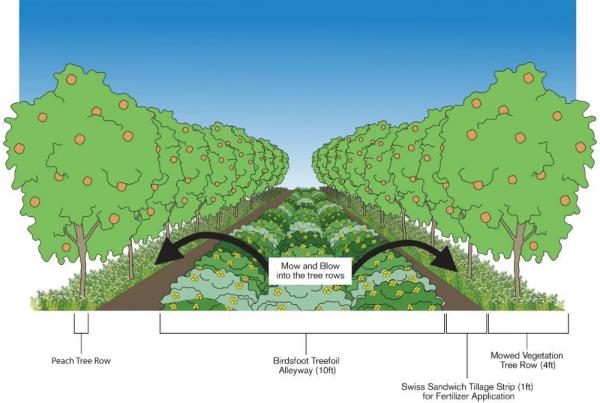
Figure 1. Orchard Floor Management System. A mowed-vegetation with birdsfoot trefoil alleyway and Swiss sandwich tilling system is shown. Image designed by Lexi Koyle, Utah State University.
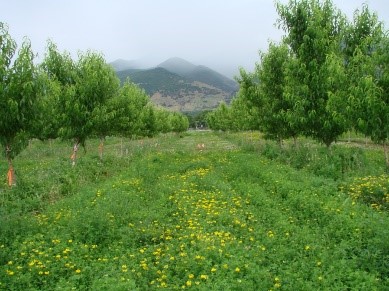
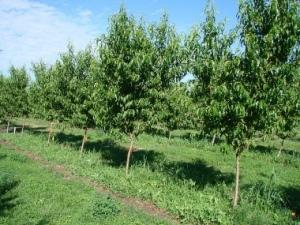
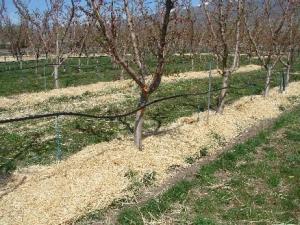
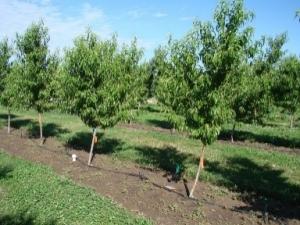
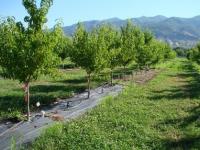
Figure 2. Orchard Floor Management Practices. Mowed-vegetation tree row with birdsfoot trefoil alleyway (top-left). Mowed-vegetation tree row with grass alleyway (top-middle). Straw-mulch tree row with grass alleyway (bottom-left). Tillage tree row with grass alleyway (bottom-middle). Weed-fabric tree row with grass alleyway (bottom-right). Trees are shown at third leaf. Photo credit: Jennifer Reeve, Utah State University.
Alleyway Management Practices
Weed Management
Weed fabric and tillage practices in the tree row will initially promote more vigorous tree growth. By the third year, trees grown in birdsfoot trefoil alleyways were as large as those grown with the weed-free practices (Figs. 4 and 5). This suggests that trees grown with birdsfoot trefoil alleyways access more nutrients and water to support tree growth despite an increase in weed pressure.
Fertility Management
Managing fertility in an organic system can be a challenge, as most naturally-derived fertilizers contain insufficient nitrogen relative to other nutrients, leading to an oversupply of phosphorus and potash. Compost is best applied at rates that meet phosphorus needs with legumes, and other N-rich organic fertilizers such as feather meal (13-0-0) to balance additional N needs. See USU Horticulture Extension publication Strategies for Managing Soil Fertility and Health in Organic Orchards (Thomsen et al., 2018).
Organic peach establishment trials at USU have shown that after the third year of establishment (2011), total average N inputs per tree increased by 147% and 180% for a mowed-vegetation tree row with birdsfoot trefoil alleyway and straw mulch with birdsfoot trefoil alleyway relative to the same tree row management with grass alleyways. This is especially promising as the orchard can produce its own N.
This increase in N leads to an increase in trunk cross sectional area (TCSA), which indicates more vigorous tree growth during establishment. A legume alleyway has been shown to allow the roots of the fruit trees to access available N in the alleyway compared to a grass alleyway. This occurs because the tree roots can grow between taproots found in legumes compared to the branching root system of turf grasses (Black et al., 2010). Growth in tillage and weed fabric rows did not differ significantly from the birdsfoot trefoil alleyways, but all three practices consistently outperformed the grass alleyway during the second to fourth year of growth (Fig. 3). This suggests that grass alleyways slow tree growth in organic systems, because they restrict tree root access to nutrients.
Figure 3. Alleyway Trunk Cross Sectional Area. By the third year (2011) of establishment, trees planted with grass alleyways were significantly smaller than trees planted in birdsfoot trefoil alleyways, as well as tilled and weed-fabric tree rows. Higher values indicate thicker tree trunks; and thus, faster establishment. Different letters indicate different groups of significance. Data originally published in Reeve, et al., 2017.
When legume readily-available-N is insufficient, feather meal (13-0-0) may serve as an N-rich organic fertilizer. Caution should be used for continued use after orchard and legume establishment so as not to oversupply N and cause problems with excess tree vigor and reduced fruit quality. However, research conducted in Utah shows that a legume-compost-feather meal fertility management plan can effectively provide adequate fertility for organic orchard establishment and maintenance (Reeve et al., 2017).
Tree Row Management Practices
Weed Management
Young fruit trees are particularly susceptible to weed pressure that competes for nutrients and water. Weeds and other biomass also provide refuge for pests which can be difficult to manage in an organic system. Choosing the right weed management approach for your orchard is essential.
Trees planted with legume alleyways, and tree-row weeds managed with either mowing or straw mulch, exhibited as much annual tree growth as treatments with active weed control in the tree row such as tillage or weed fabric. Birdsfoot trefoil planted in the orchard alleyway can significantly reduce the negative effects of weed competition relative to orchards with grass alleyways. Straw mulch reduced weed densities in the tree row, but no corresponding increase in tree growth was noted. Figure 4 outlines weed densities over the growing season, while Figure 5 outlines the amount of bare ground within each tree row throughout the growing season.
Figure 4. Weed densities within tree row throughout growing season. Different letters indicate different groups of significance. Higher values indicate greater weed pressure. Data originally published in Reeve, et al., 2017.
Figure 5. Bare ground within tree row throughout growing season. Different letters indicate significance. Higher values indicate less weed pressure. Data originally published in Reeve, et al., 2017.
Fertility Management
A tree-row fertility management plan should build upon tree-row weed management. Weed fabric is the most efficient tree-row method for controlling weed competition, as shown in Figure 5. However, weed fabric does not contribute to soil fertility that reduces off-farm inputs, and it is expensive to install and maintain. A mowed-vegetation tree row (mow and blow) system where the legume alleyway and tree-row residue is added into the tree row recycles N and may shade out harmful weed competition. A mowed-vegetation tree row in combination with a birdsfoot trefoil alleyway also promotes tree growth similar to straw and tillage tree-row practices (Reeve et al., 2017).
Insect Management
Using legume alleyways in orchards will increase cat-facing insects, such as lygus bugs (Lygus lineolaris). However, an increase in lygus bug populations did not carry over into the canopy and, as a result, legume alleyways did not increase fruit damage. Earwig (Forficula auricularia) populations also increased with management practices that increased ground cover (e.g., tree rows with straw mulch or native vegetation, or a birdsfoot trefoil alleyway). Increased lygus bugs and earwigs in the ground vegetation can be managed by routine mowing of the alleyway, and if needed, approved organic pesticide sprays. An earwig-specific management option is the use of organic earwig baits, such as those with spinosad as the active ingredient. It is important to note that during organic trials, no pest management sprays were used.
Fruit Yield
Trees that were grown with weed-fabric tree rows produced the highest number of fruit, while the birdsfoot trefoil and bare-ground systems produced comparable yields. The living mulch and straw tree-row systems grew smaller trees, and as a result, produced less fruit.
Profitability
Reduced off-orchard inputs for fertilizer, herbicides, and pesticides can be achieved through organic orchard-floor management practices, which represents an opportunity for reduced expenses. Organic methods allow the producer to generate their own fertilizer, manage weed pressure, and maintain beneficial predators that control pests within the boundaries of the orchard. Other expenses, such as labor, machinery, etc., may increase to due to organic methods. Yields from these organically managed orchards are comparable to conventional orchards but receive a price premium for organic certification. Therefore, organic orchards have the potential to be more profitable than conventionally managed orchards. For full details regarding profitability, see USU Applied Economics Fact Sheet Northern Utah Organic Peach Orchard Costs and Returns, 20 Acres, 2015 (Knudsen et al., 2016).
Concerns
Establishing birdsfoot trefoil in the alleyways can be difficult since birdsfoot trefoil growth is initially slow, giving weeds time to develop. One method to reduce weed pressure is to seed oats at a low rate (15 lb/acre) as a companion crop to birdsfoot trefoil (Brummer et al., 2016). Applying herbicide to clean alleyway and tree rows of weeds prior to legume establishment can be considered in non-organic systems. In certified organic systems, careful site preparation using cover crops and tillage to manage the weed-seed bank can be effective when combined with fall establishment (Brummer et al., 2016). The use of straw should be used with caution as it may introduce additional weed seeds, depending upon purity the source. Establishing a birdsfoot trefoil alleyway may be difficult in older, previously-established orchards due to a developed weed-seed bank and a larger tree canopy that shades out the alleyway. A legume alleyway is best established with the orchard.
The increased N in the fall provided by legumes has the potential to delay dormancy by increasing tree vigor and should be carefully managed. Destructive insect populations should be monitored carefully as the increased groundcover biomass will provide habitat if not managed properly. Routine monthly mowing is essential to reduce pest habitat.
It is important to note that using weed fabric and straw mulch for tree row management increases maintenance. Each winter, the weed fabric and straw mulch must be pulled back to control rodent populations. Weed fabric must be removed in order to apply compost as well.
Summary
Organic tree growth is equivalent to or greater than conventional systems (Reeve et al., 2017). An orchard established with birdsfoot trefoil alleyways can provide additional nitrogen to compensate for increased weed competition and still reduce cost of inputs. For sustainable profitability in organic systems, weed competition and soil fertility must be managed from establishment. The approach described in this report has the potential to be applied to other organic tree-fruit systems upon further research.
Acknowledgements
This research project was funded through the USDA-OREI program, the Utah Department of Agriculture and Food Specialty Crop Block Grant program, and the Utah Agricultural Experiment Station. Many thanks go out to the supporting authors for their work in providing best practices for managing organic peach systems in Utah and the Intermountain West.
References
- Black, B. L., D. Drost, T. Lindstrom, J. Reeve, J. Gunnell, and G. L. Reighard. 2010. A comparison of root distribution patterns among Prunus rootstocks. Journal of the American Pomological Society 64: 52—62. (Available online at: https://www.researchgate.net/publication/231175182_A_Comparison_of_Root_Distribution_Patterns_Among_Prunus_Rootstocks) (verified 24 July 2019).
- Black, B., G. Cardon, and M. Rowley. 2012. Alternative orchard floor management strategies [Online]. Utah State University Cooperative Extension, Horticulture/Fruit/2012-01pr. Available at: https://extension.usu.edu/productionhort/files-ou/Alternative-Orchard-Floor-Management-Strategies.pdf. (verified 24 July 2019)
- Brummer, J. E., J. W. MacAdam, G. Shewmaker, and M. A. Isllam. 2016. Establishing birdsfoot trefoil in the Mountain West [Online]. Utah State University, AG/Forages/2016-02pr. Available at: https://digitalcommons.usu.edu/cgi/viewcontent.cgi?article=2612&context=extension_curall (verified 24 July 2019).
- Knudsen, Trevor D. 2015. Economic assessment of organic, eco-friendly, and conventional peach production methods in northern Utah [Online]. MS Thesis. Utah State University Available at: https://digitalcommons.usu.edu/etd/4019/. (verified 24 July 2019).
- Knudsen, T., K. Curtis, J. Reeve, and B. Black. 2016. Northern Utah organic peach orchard costs and returns, 20 acres, 2015. [Online]. Utah State University Extension, AppliedEconomics/2016-01pr. Available at: https://digitalcommons.usu.edu/cgi/viewcontent.cgi?article=2618&context=extension_curall (verified 24 July 2019).
- Reeve, J. R., C. M. Culumber, B. L. Black, A. Tebeau, C. V. Ransom, D. Alston, M. Rowley, and T. Lindstrom. 2017. Establishing peach trees for organic production in Utah and the Intermountain West. Scientia Horticulturae 214: 242—251. (Available online at: https://doi.org/10.1016/j.scienta.2016.11.040 (verified 29 July 2019).
- Thomsen, E. O., C. M. Culumber, J. R. Reeve, G. Cardon, D. Alston, B. L. Black, and C. V. Ransom. 2018. Strategies for managing soil fertility and health in organic orchards—A fact sheet [Online]. Utah State University Extension. Horticulture/Orchards/2018-01. Available at https://digitalcommons.usu.edu/cgi/viewcontent.cgi?article=2903&context=extension_curall (verified 29 July 2019).
Additional Resources
- Model FP & FPA & FPXA, 2018. URL https://multivator.wordpress.com/model-fp-fpa-fpxa/ (verified 29 July 2019).



